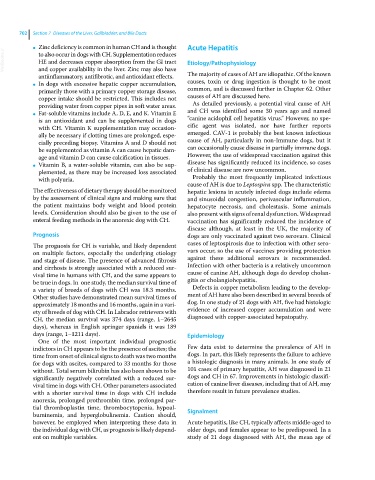Page 734 - Clinical Small Animal Internal Medicine
P. 734
702 Section 7 Diseases of the Liver, Gallbladder, and Bile Ducts
Zinc deficiency is common in human CH and is thought Acute Hepatitis
●
VetBooks.ir to also occur in dogs with CH. Supplementation reduces Etiology/Pathophysiology
HE and decreases copper absorption from the GI tract
and copper availability in the liver. Zinc may also have
antiinflammatory, antifibrotic, and antioxidant effects. The majority of cases of AH are idiopathic. Of the known
In dogs with excessive hepatic copper accumulation, causes, toxin or drug ingestion is thought to be most
●
primarily those with a primary copper storage disease, common, and is discussed further in Chapter 62. Other
copper intake should be restricted. This includes not causes of AH are discussed here.
providing water from copper pipes in soft water areas. As detailed previously, a potential viral cause of AH
Fat‐soluble vitamins include A, D, E, and K. Vitamin E and CH was identified some 30 years ago and named
●
is an antioxidant and can be supplemented in dogs “canine acidophil cell hepatitis virus.” However, no spe-
with CH. Vitamin K supplementation may occasion- cific agent was isolated, nor have further reports
ally be necessary if clotting times are prolonged, espe- emerged. CAV‐1 is probably the best known infectious
cially preceding biopsy. Vitamins A and D should not cause of AH, particularly in non‐Immune dogs, but it
be supplemented as vitamin A can cause hepatic dam- can occasionally cause disease in partially immune dogs.
age and vitamin D can cause calcification in tissues. However, the use of widespread vaccination against this
Vitamin B, a water‐soluble vitamin, can also be sup- disease has significantly reduced its incidence, so cases
●
plemented, as there may be increased loss associated of clinical disease are now uncommon.
with polyuria. Probably the most frequently implicated infectious
cause of AH is due to Leptospira spp. The characteristic
The effectiveness of dietary therapy should be monitored hepatic lesions in acutely infected dogs include edema
by the assessment of clinical signs and making sure that and sinusoidal congestion, perivascular inflammation,
the patient maintains body weight and blood protein hepatocyte necrosis, and cholestasis. Some animals
levels. Consideration should also be given to the use of also present with signs of renal dysfunction. Widespread
enteral feeding methods in the anorexic dog with CH. vaccination has significantly reduced the incidence of
disease although, at least in the UK, the majority of
Prognosis dogs are only vaccinated against two serovars. Clinical
The prognosis for CH is variable, and likely dependent cases of leptospirosis due to infection with other sero-
on multiple factors, especially the underlying etiology vars occur, so the use of vaccines providing protection
and stage of disease. The presence of advanced fibrosis against these additional serovars is recommended.
and cirrhosis is strongly associated with a reduced sur- Infection with other bacteria is a relatively uncommon
vival time in humans with CH, and the same appears to cause of canine AH, although dogs do develop cholan-
be true in dogs. In one study, the median survival time of gitis or cholangiohepatitis.
a variety of breeds of dogs with CH was 18.3 months. Defects in copper metabolism leading to the develop-
Other studies have demonstrated mean survival times of ment of AH have also been described in several breeds of
approximately 18 months and 16 months, again in a vari- dog. In one study of 21 dogs with AH, five had histologic
ety of breeds of dog with CH. In Labrador retrievers with evidence of increased copper accumulation and were
CH, the median survival was 374 days (range, 1–2645 diagnosed with copper‐associated hepatopathy.
days), whereas in English springer spaniels it was 189
days (range, 1–1211 days). Epidemiology
One of the most important individual prognostic
indictors in CH appears to be the presence of ascites; the Few data exist to determine the prevalence of AH in
time from onset of clinical signs to death was two months dogs. In part, this likely represents the failure to achieve
for dogs with ascites, compared to 33 months for those a histologic diagnosis in many animals. In one study of
without. Total serum bilirubin has also been shown to be 101 cases of primary hepatitis, AH was diagnosed in 21
significantly negatively correlated with a reduced sur- dogs and CH in 67. Improvements in histologic classifi-
vival time in dogs with CH. Other parameters associated cation of canine liver diseases, including that of AH, may
with a shorter survival time in dogs with CH include therefore result in future prevalence studies.
anorexia, prolonged prothrombin time, prolonged par-
tial thromboplastin time, thrombocytopenia, hypoal- Signalment
buminemia, and hyperglobulinemia. Caution should,
however, be employed when interpreting these data in Acute hepatitis, like CH, typically affects middle‐aged to
the individual dog with CH, as prognosis is likely depend- older dogs, and females appear to be predisposed. In a
ent on multiple variables. study of 21 dogs diagnosed with AH, the mean age of

